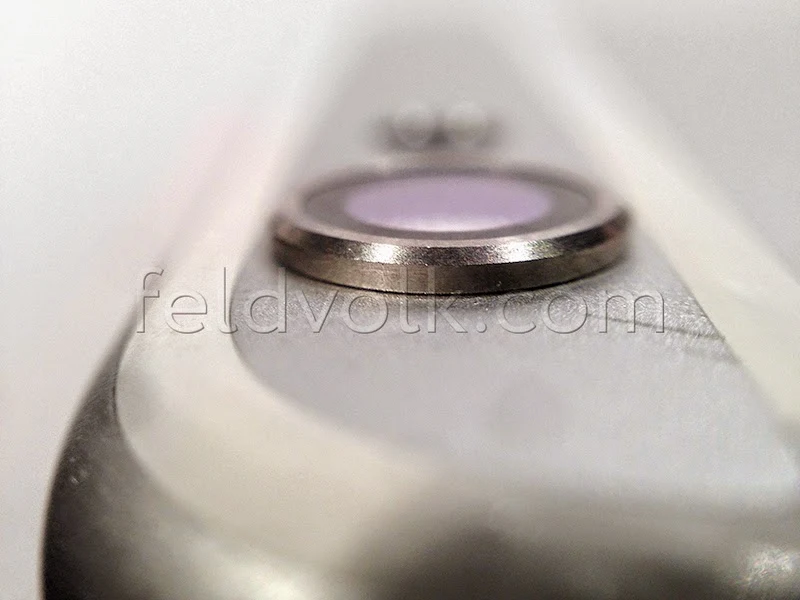A month ago, the luxury modified iPhone vendor, Feld & Volk – Instagram page, shared a few high quality photos and video of the purported rear shell of the iPhone, while it had not been polished or fully processed and was in an intermediate stage of production, though it still offers a look at the body of the device. Feld & Volk who has received the completed 4.7 inch iPhone 6 rear shell, has shared some of the new photos, revealing some features not indicated in the earlier information.
These include a good look at the volume button cut-outs which have been slightly recessed in a change enabling a lower profile along the edges with decreased likelihood of accidental volume changes. The new images are put on display and are believed to be the final casing for the 4.7 inch iPhone 6 and with it we now have some details which had not been given earlier. Similar recesses have also been seen, on a purported perfect replica for the volume buttons and have been claimed as actual rear shell for the iPad Air.
Extraordinary Scratch Resistance Metal
A look at the embedded Apple logo by Feld & Volk’s photos is also offered, which Apple has not used on the iPhone from the time of the original iPhone in 2007 and as per Feld & Volk’s statement, the embedded logo is said to be similar to the original iPhone and it is made of very extraordinary scratch resistant metal which is presumed to be of liquid metal alloy, though there is no specific proof which supports this issue.
Another image portrays it to be an external camera ring measuring 6.66 mm in diameter and fits accurately on the rear camera hole of the shell. Design drawings and physical mock-ups which have been revealed convey that the 5.5 inch iPhone 6 would be seeing a protruding rear camera as in the case of the current iPod touch though the rumours have shown it to be a flush camera for the smaller 4.7 inch model. It is now left to be seen if the camera ring would be paired with the rear shell of the 4.7 inch model or not.
Flex cable, New Home Button
The last image is shown with a flex cable which is the source for the iPhone 6 and as in the case of the previous rumour, it is speculated by Feld &Volk that it could be the new home button but as MacRumours points out that based on its length it more likely tuned towards the flex cable for an iPad and not for its upcoming iPhone..
Apple is all set to launch the iPhone 6 very soon during the event which will be coming up in September and it is confirmed that Apple will be holding its annual iPhone media event then though it is not clear that both 4.7 inch as well as 5.5 inch models would be arriving together. Probably, the 4.7 inch model would be launched roughly one and a half week after the event based on earlier release patterns.
These include a good look at the volume button cut-outs which have been slightly recessed in a change enabling a lower profile along the edges with decreased likelihood of accidental volume changes. The new images are put on display and are believed to be the final casing for the 4.7 inch iPhone 6 and with it we now have some details which had not been given earlier. Similar recesses have also been seen, on a purported perfect replica for the volume buttons and have been claimed as actual rear shell for the iPad Air.
Extraordinary Scratch Resistance Metal
A look at the embedded Apple logo by Feld & Volk’s photos is also offered, which Apple has not used on the iPhone from the time of the original iPhone in 2007 and as per Feld & Volk’s statement, the embedded logo is said to be similar to the original iPhone and it is made of very extraordinary scratch resistant metal which is presumed to be of liquid metal alloy, though there is no specific proof which supports this issue.
Another image portrays it to be an external camera ring measuring 6.66 mm in diameter and fits accurately on the rear camera hole of the shell. Design drawings and physical mock-ups which have been revealed convey that the 5.5 inch iPhone 6 would be seeing a protruding rear camera as in the case of the current iPod touch though the rumours have shown it to be a flush camera for the smaller 4.7 inch model. It is now left to be seen if the camera ring would be paired with the rear shell of the 4.7 inch model or not.
Flex cable, New Home Button
The last image is shown with a flex cable which is the source for the iPhone 6 and as in the case of the previous rumour, it is speculated by Feld &Volk that it could be the new home button but as MacRumours points out that based on its length it more likely tuned towards the flex cable for an iPad and not for its upcoming iPhone..
Apple is all set to launch the iPhone 6 very soon during the event which will be coming up in September and it is confirmed that Apple will be holding its annual iPhone media event then though it is not clear that both 4.7 inch as well as 5.5 inch models would be arriving together. Probably, the 4.7 inch model would be launched roughly one and a half week after the event based on earlier release patterns.





